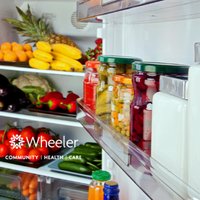How to Reduce Food Waste

With food costs rising, healthy eating can be more difficult, and the last thing you want to do is throw food away.
Jessica Masterson, RDN, CDN, CDCES, Wheeler's registered dietitian nutritionist, says when meeting with clients for nutrition education, they often talk about eating more fruits and vegetables. A common response she get is, “I buy them, and they go bad.”
We get it. Who has not bought a container of beautiful strawberries to have them turn mushy in a few days? Or purchased a bunch of leafy greens to have them wilt away in the produce drawer?
Here are some tips to help reduce your food waste, which can not only help you save money but may also help you reach your health goals.
Make it visible!
- Leave fruit that does not need to be refrigerated visible on the table or counter.
- Put leftovers clearly labeled and at the front of the fridge.
- While you are cleaning up dinner, pack leftovers in individual serving-sized containers to bring for lunch.
- Put produce on the shelf at eye level.
- Have a designated space to store foods that need to be eaten quickly.
Prep it!
- Rinse apples. Wash and cut peppers, carrots, cauliflower, broccoli, and other sturdy fruits and vegetables as soon as you buy them.
- Some delicate fruits and vegetables like berries, mushrooms, and leafy greens may be best washed and prepared right before use.
- Do not forget about your meat. If you buy large packs of meat, break it up into smaller packages and trim before you freeze it. You can also add a marinade before you freeze – then it is all set to cook when you need it.
Use it when you see it!
- If you look in the fridge, see the strawberries and think they need to be eaten – do it or freeze them right away.
- Fruit that you do not think you will be able to eat can be washed, cut, and frozen for use in smoothies or oatmeal.
- If you see something in the cupboard that you are likely not to use, instead of holding on to it, donate it before it expires.
Shop smart!
- Have a list and stick to it.
- Check through your cupboards, freezer, and fridge before making your list – so you can try to use things you have and to make sure you do not buy multiples of things you do not need.
- Purchasing produce in season may last longer, taste better, and be less expensive.
Get creative!
- Have left over night, and put everything out on the table for the family to make their own meals.
- Leftovers can be added to a bed of leafy greens to make a salad or thrown on top of noodles or rice or stuffed into a wrap.
- Cut up leftover vegetables from dinner to throw in an omelet the next day.
- When cutting vegetables, save the stems and pieces you are not going to cook with to make a vegetable broth. They can be stored in the freezer until you are ready to use.
- You might not want to eat strawberry tops, but they are edible. Try tossing them into a smoothie!
Remember, do not use things that have mold, are slimy, smell bad. If you are unsure, throw it out.
Wondering when food should be disposed of? Check out the FoodKeeper app for information on expiration dates, use by dates and food safety.
Here are some links on food safety, storage, and tips for reducing food waste.
Tips to Reduce Food Waste | FDA
Are You Storing Food Safely? | FDA
Need ideas for something to do with your leftovers? Check out Big Oven. You can enter up to three ingredients and they will give you recipe ideas.
Looking for a fun recipe to use up some extra produce or leftovers? Check out this recipe for Kitchen Sink Soup.





